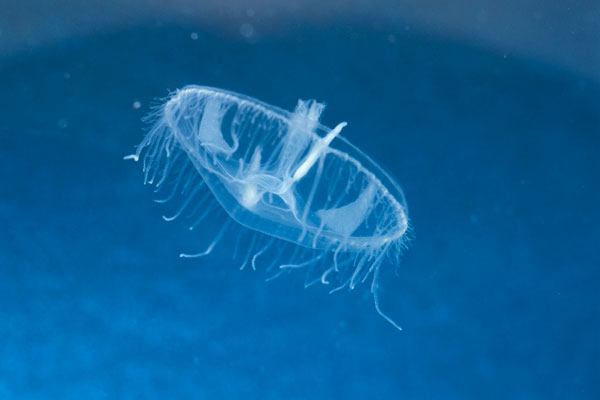
By Dan Zarlenga, Missouri Department of Conservation
Photo Caption: A beautiful freshwater jellyfish deploys its venomous tentacles.
Photo by Jim Rathert, Missouri Department of Conservation
According to ancient Greek mythology, there once existed a female creature known as the Medusa. It’s said she possessed the ability to instantly turn those who gazed upon her to stone, and that her hair was made up of venomous snakes! One day, a young warrior named Perseus cleverly used a mirror to avoid looking directly at Medusa, and he slew her by cutting off her head.
Medusas still exist though, and they are in the waters of Missouri, complete with a head full of snakes.
Medusa is the name given to a stage of life of a strange aquatic creature—the freshwater jellyfish. It may be surprising to learn that there are jellyfish in the Show-Me State, but the creatures can sometimes be found in ponds, lakes, reservoirs, and quiet or sluggish pools near flowing water throughout the state. They avoid current, so you only have a chance of seeing jellyfish in still water.
They are non-native to the U.S., believed to have hitched a ride to this country from their home in China’s Yangtze River valley. Unlike many species introduced from elsewhere though, freshwater jellyfish thankfully do not seem to have a negative impact on our native aquatic ecosystems.
For most of a jellyfish’s life, they exist as a polyp, less than 1/8-inch in size. Completely immobile, the minuscule polyps spend this stage of their lives clinging to snags, logs, and other structures underwater. They wait for zooplankton, worms, and larval fish to float by and eat them. Polyps reproduce asexually by creating buds that become identical copies of the original organism. At this phase of life, you might say these jelly-fish only come in one flavor!
However, it’s only when conditions are just right, usually after water temperatures climb to 80 degrees Fahrenheit, that jellyfish as if by magic develop graceful, delicate, umbrella-shaped bodies. This is the medusa phase, and it will typically occur late in summer, between July and September. It is in this state that jellyfish differentiate into males and females.
Bigger than the polyp stage, but still small, medusas grow no more one inch in size. Their appearance is ethereal—translucent forms that can reveal subtle tints of tan, gray, white, green, or blue. Some say the Medusa of mythology was beautiful, and so too are these medusas.
Likewise, jellyfish medusas sport their own mane of “snakes”. The serpents take the form of 400 or so tentacles, complete with the ability to emit stinging venom. Jellyfish use them to turn their prey to stone, immobilizing tiny aquatic creatures and zooplankton to feed on. The medusa glides in a supple rhythm up and down the water column in search of meals.
Unlike their saltwater counterparts, the minute stingers of freshwater jellyfish tentacles can’t penetrate human skin, so they don’t pose much of a problem for people. It turns out that the freshwater jellyfish has its own nemesis. Native crayfish are like Perseus to these Medusas. Observations show that the crustations eagerly devour jellyfish, like kids gobbling down peanut butter and jelly sandwiches. Perhaps that’s what keeps these non-native jellyfish in check.
Think of it. Next time you gaze upon a local pond in late summer, the epic duel between Perseus and the snake-haired Medusa may play out countless times just below the surface in front of you! www.mdc.gov


